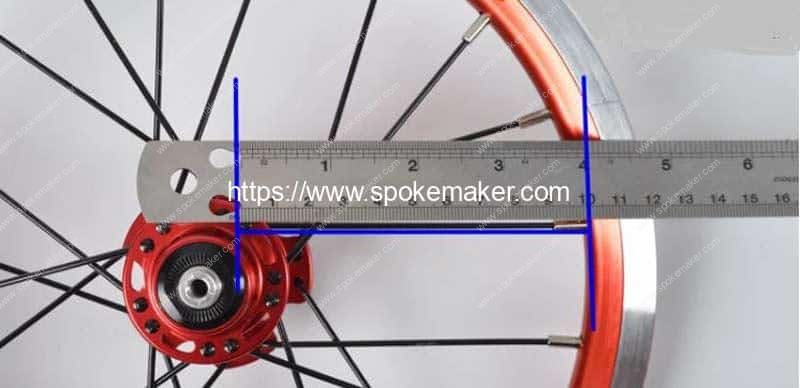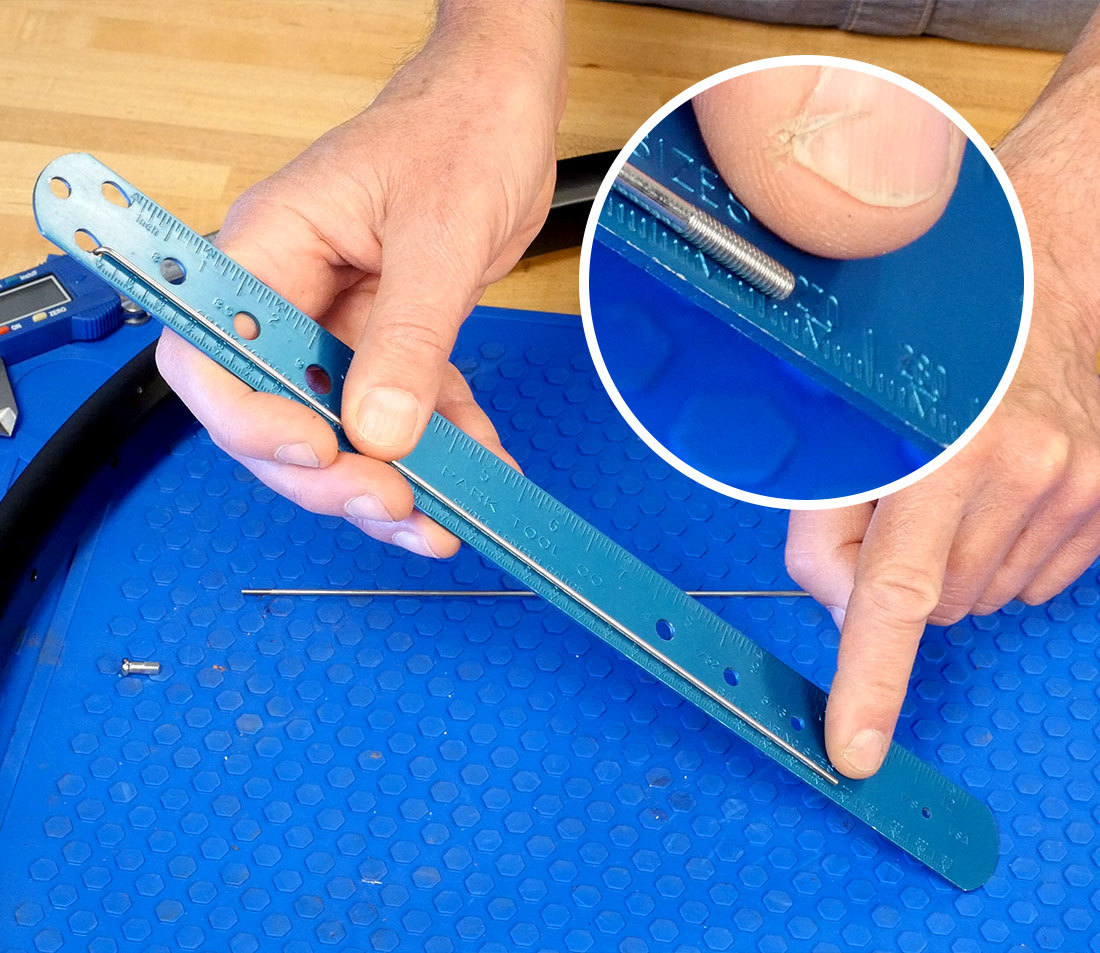To measure bicycle spokes, you need a few tools. Most importantly, a spoke ruler or caliper.
Bicycle spokes play a crucial role in your bike’s performance and safety. Knowing how to measure bicycle spokes accurately is essential for maintenance and repairs. Whether you’re replacing a broken spoke or building a new wheel, getting the measurements right ensures a perfect fit.
In this guide, we’ll walk you through the process step-by-step, making it easy to understand. You’ll learn how to measure the length and diameter of your spokes with precision. This knowledge will help you keep your bike in top shape. Ready to explore? Let’s get started with the basics of measuring bicycle spokes.

Credit: www.spokemaker.com
Table of Contents
Preparing Your Bicycle
Measuring bicycle spokes accurately ensures a smooth and safe ride. Proper preparation of your bike is essential. Follow these steps to get your bicycle ready.
Cleaning The Wheels
Start by thoroughly cleaning the wheels. Use a soft brush and soapy water. Gently scrub the rims, spokes, and hub. This removes dirt and debris. Rinse well with clean water. Wipe the wheels dry with a soft cloth.
A clean wheel makes it easier to inspect and measure the spokes. It also prevents dirt from interfering with the measurement process.
Inspecting The Spokes
Next, inspect the spokes for any damage. Look for bends, cracks, or rust. Use a flashlight for a detailed inspection. Spin the wheel and check each spoke individually. Ensure all spokes are intact and in good condition.
If you find any damaged spokes, replace them before measuring. Damaged spokes can affect the accuracy of your measurements.
Use a spoke wrench to check the tension of each spoke. Lightly squeeze pairs of spokes together. They should feel firm and even. Loose or uneven tension can indicate a problem.
Now that your bike is clean and the spokes are inspected, you are ready to measure the spokes accurately.

Credit: www.parktool.com
Measuring Spoke Length
Knowing how to measure bicycle spokes is essential for bike maintenance. Accurate spoke length ensures your wheel remains balanced and strong. Follow these steps to measure spoke length effectively.
Removing The Spoke
First, you need to remove the spoke from the wheel. Use a spoke wrench to loosen the nipple. Carefully unscrew it until the spoke comes free. Make sure not to damage the nipple or the spoke threads.
Using A Ruler Or Spoke Gauge
Once the spoke is removed, you can measure its length. Lay the spoke flat on a ruler. Ensure the ruler starts at zero. Measure from the inside of the bend to the tip of the spoke.
For more accuracy, use a spoke gauge. Place the spoke in the gauge slot and read the measurement. This method reduces errors and is more reliable than a ruler.
Recording The Measurement
After measuring, write down the length. Double-check your measurement for accuracy. Correct spoke length is crucial for wheel stability.
Calculating Spoke Tension
Calculating spoke tension is a critical step in ensuring your bicycle wheels are properly balanced and durable. The right tension keeps your wheels true and helps avoid common issues like broken spokes or wobbly rides. In this section, we will guide you through the basics of spoke tension and how to measure it accurately using a spoke tension meter.
Understanding Tension Basics
Before exploring the measurement process, it’s important to grasp the basics of spoke tension. Spoke tension refers to the tightness of the spokes on your bicycle wheel. Proper tension ensures the wheel remains strong and true. Even spoke tension across all spokes is crucial for wheel longevity and performance.
Typically, spoke tension is measured in kilograms force (kgf) or Newtons (N). Different types of spokes and wheels require different tension levels. Check your bicycle’s manual or manufacturer guidelines for the recommended tension range.
Using A Spoke Tension Meter
A spoke tension meter is a handy tool to measure the tension of your bicycle spokes. Here’s a step-by-step guide to using one:
- Prepare your bike: Ensure your bike is stable and the wheel can spin freely.
- Identify the spokes: Choose a spoke to measure, typically starting near the valve hole.
- Attach the meter: Place the spoke tension meter on the spoke, ensuring it sits properly.
- Read the measurement: Squeeze the handles of the tension meter and note the reading on the scale.
- Repeat: Measure multiple spokes around the wheel to ensure even tension.
Using a spoke tension meter is straightforward. Here’s a simple table to illustrate the process:
| Step | Action |
|---|---|
| 1 | Stabilize the bike |
| 2 | Select a spoke |
| 3 | Attach the meter |
| 4 | Squeeze and read |
| 5 | Repeat for accuracy |
Consistency is key in spoke tension. Regularly check and adjust as needed. Proper tension ensures a smooth and safe ride.
Documenting Measurements
Accurate documentation is crucial for maintaining your bicycle spokes. By keeping precise records, you can ensure your bike’s performance and safety. Let’s explore how to document the measurements effectively.
Recording Length And Tension
First, measure each spoke’s length. Use a ruler or spoke gauge. Write down the lengths in a notebook or digital file. Consistency is key. Check the spoke tension using a tension meter. Record the tension readings next to the length measurements. This helps in future adjustments.
Creating A Maintenance Log
Create a log to track your bike’s maintenance. Note each measurement and adjustment. Include dates and any issues found. This log will help identify patterns over time. It ensures you address problems before they worsen.
Documenting these details keeps your bike running smoothly. It also simplifies future maintenance tasks. Stay consistent with your logs for the best results.
Troubleshooting Common Issues
Measuring bicycle spokes accurately is crucial for ensuring a smooth ride. But sometimes, issues arise that can complicate the process. Whether it’s incorrect measurements or other common problems, troubleshooting is key. This section will guide you through identifying and correcting common issues with measuring bicycle spokes.
Identifying Incorrect Measurements
Incorrect measurements can lead to various problems. First, check the ruler or caliper used. Ensure it is properly calibrated. Measure a known length to verify accuracy. Next, examine the spoke itself. Bent or damaged spokes can distort measurements. Replace any damaged spokes before measuring.
Pay attention to the spoke’s threading. Measure from the end of the thread, not the tip of the spoke. This ensures you get the correct length. Also, double-check your measurement points. Measure from the hub end to the outer edge of the rim. Missing these details can lead to incorrect measurements.
Correcting Mistakes
If you find a mistake, don’t worry. Correcting it is usually straightforward. Start by re-measuring the spoke. Use a calibrated tool for accuracy. If the spoke was bent, replace it and measure again. Ensure the spoke is straight and undamaged.
Next, verify your measurement points. Measure from the correct starting and ending points. If you measured incorrectly, adjust and measure again. Recheck your measurements to confirm accuracy. By following these steps, you can correct any mistakes and ensure your bicycle spokes are measured accurately.
Reinstalling Spokes
Measuring bicycle spokes accurately ensures a perfect fit. Use a spoke ruler or caliper to determine the correct length. Accurate measurement prevents wheel misalignment and enhances riding performance.
Reinstalling bicycle spokes can seem tricky. But it’s not too hard. You just need some patience. And the right steps.
Reattaching The Spoke
First, get your spoke. Check that it’s the right size. Insert the spoke into the hub. Make sure it’s secure. Now, guide the spoke through the rim hole. Use your fingers to align it properly.
Next, thread the nipple onto the spoke. Use a spoke wrench to tighten it. Don’t make it too tight yet. Just snug enough to hold. Move on to the next spoke. Repeat the steps until all spokes are in place.
Ensuring Proper Tension
Now, check the tension of each spoke. Use a spoke tension meter if you have one. Or, pluck each spoke like a guitar string. They should all sound similar.
Adjust the tension if needed. Use your spoke wrench. Turn it a little at a time. Check the tension again. Repeat this process until all spokes have the same tension.
Proper tension keeps your wheel strong. And helps it stay true. So take your time. Get it right.
Regular Maintenance Tips
Measuring bicycle spokes is essential for bike maintenance. Use a ruler or spoke ruler to find the correct length. Accurate measurement ensures a smooth ride and prevents wheel damage.
Proper maintenance of your bicycle spokes ensures safety and longevity. Regular checks can prevent problems before they become severe. Here are some essential tips to keep your spokes in top condition.
Routine Inspections
Check your spokes regularly for any signs of damage or wear. Spin the wheel and listen for any unusual noises. Look for loose or broken spokes. Tighten any loose spokes using a spoke wrench. Ensure the wheel remains true and straight.
When To Replace Spokes
Replace spokes if you notice cracks or bends. Damaged spokes can affect the wheel’s stability. Replace multiple spokes if several are damaged. This can prevent further issues. Always use the correct spoke length and type for your bike.
Regular maintenance can extend the life of your bicycle. Keep these tips in mind for a smoother and safer ride.
Frequently Asked Questions
How To Measure Bicycle Spokes?
To measure bicycle spokes, use a spoke ruler or caliper. Measure from the bend to the thread end. Ensure you get the exact length.
What Tools Do I Need To Measure Spokes?
You’ll need a spoke ruler or caliper. These tools help you get precise measurements for your bicycle spokes.
Why Is Spoke Length Important?
Correct spoke length ensures proper wheel tension and stability. Incorrect lengths can cause wheel imbalance or spoke breakage.
Can I Measure Spokes Without Removing Them?
Yes, you can measure spokes without removing them. Use a spoke ruler to measure from the bend to the thread end.
Conclusion
Measuring bicycle spokes is simple with the right tools and steps. Accurate measurements ensure a smooth ride and a longer lifespan for your bike. Always double-check your work to avoid errors. Regular maintenance keeps your bike in top shape. By following these guidelines, you can confidently measure your bicycle spokes.
Happy cycling!

